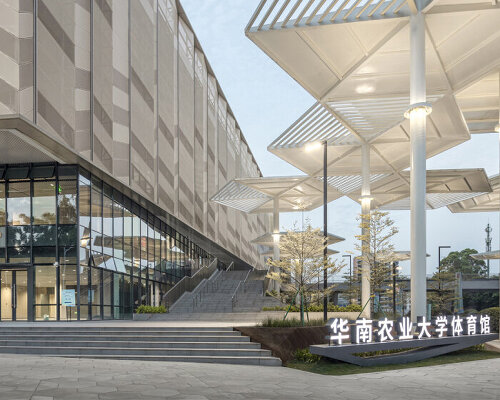scut’s gymnasium embeds an open community design
The Gymnasium of South China Agricultural University, the first university gymnasium in South China to adopt an open community design, redefines expressions of sports architecture. Rejecting conventional enclosed forms, it integrates shared community services and mixed-use functions while creating vibrant outdoor spaces — including a tree-canopy square, skatepark, pedestrian arcade, and multi-level platform — to serve as a dynamic hub for campus and community activities. By prioritizing daily usability, Architectural Design & Research Institute of SCUT’s concept strengthens its integration into campus life, fostering a lively, multifunctional space that enriches university landscapes with new social memories.
all images courtesy of Architectural Design & Research Institute of SCUT
the complex in south china bridges mixed athletic functions
23.7 meters in height, the three-floor, 52,450-square-meter complex houses a main competition hall, training facilities, and a natatorium. Located east of South China Agricultural University’s main entrance, it is accessible to external communities while anchoring the campus’s east-west axis. The 440-meter-long site, sloping 13 meters vertically, bridges the western teaching area and eastern living quarters. Situated along frequent commuting routes, the gymnasium acts as both a social catalyst and a transitional space between campus zones. Its receding volumes and understated facades harmonize with existing mature trees, ensuring seamless integration into the surrounding landscape.
Emphasizing community engagement, Architectural Design & Research Institute of SCUT’s design employs open layouts and mixed functions to transform the gymnasium into an interactive hub. Key amenities — including swimming pools, tennis courts, and training halls — are designed with transparent interfaces and positioned along campus main roads, while skateparks, climbing walls, and gyms line pedestrian pathways to encourage spontaneous interaction. This strategy not only enhances accessibility but also blurs boundaries between sports infrastructure and everyday campus life, creating a vibrant node that bridges functionality and social connectivity. Meanwhile, cafeteria and lounges are provided in the lobbies of the training hall and the natatorium, while community service functions such as stores offering cold drinks and sports goods are planned on the elevated F1. Together with steps and seats, etc., they create more public community spaces for daily social interactions among teachers and students. Such an open and integrated design approach makes the Gymnasium no longer a closed venue, but an open, vibrant community for interactions.
20 canopy-shaped sunshade structures inspired by the university logo’s ‘bud’ motif
Passive strategies support energy performance
At the corner of the competition hall and natatorium, a diagonal building volume encloses a small square featuring a skatepark, cold drinks bar, stairs, and leisure gallery for sports and social activities. Twenty canopy-shaped sunshade structures inspired by the university logo’s ‘bud’ motif create a tree-themed social hub. Adapting to subtropical climates, these canopies provide all-weather shade and microclimate comfort, enhancing daily interactions between teachers and students. A pedestrian arcade along the building facade connects the tree canopy square, leisure platform, and rest areas into an open street block, while indoor activities are visible through floor-to-ceiling glass walls that blur indoor-outdoor boundaries and foster community engagement.
Structurally, economical design reduces complexity while prioritizing natural daylighting and ventilation, which optimizes land use and cost efficiency. This approach balances functionality with cost control, ensuring the gymnasium adapts seamlessly to its multifunctional role.
emphasizing community engagement, the design employs open layouts and mixed functions
making the Gymnasium not an enclosed venue, but an open, vibrant community for interactions
a diagonal building volume encloses a small square featuring a skatepark, cold drinks bar, and leisure gallery
adapting to subtropical climates, these canopies provide all-weather shade and microclimate comfort
transforming the gymnasium into an interactive hub
creatively integrating passive energy-saving technologies, parametric design, and agricultural cultural motifs
facades feature parameterized, folded aluminum panels to facilitate ventilation
the multi-level traffic distribution strategy ensures relatively independent circulation routes for visitors
patios and courtyards are locally provided within the project to promote the ventilation stack effect
for the natatorium, frosted glass skylights are employed to regulate incoming solar heat
main hall with three-sided stands accommodating large-scale sports events, ceremonies, and performance events
project info:
name: South China Agricultural University Gymnasium
architect: Architectural Design & Research Institute of SCUT
location: South China
construction unit: China Construction Eighth Engineering Division
chief designers: He Jingtang, Qiu Jianfa, Bao Ying
architectural design: Jiang Fan, Chen Haonan, Chen Zhidong, Zeng Xianze, Liu Xiao, Zou Hongsheng, Huang Peining, Huang Zhishan, Cao Yunye, Tang Zhihong, Liao Yuqi, Luo Hongjie, Lv Yating
structural design: Guo Yuanxiang, Liao Shaoshan, Shen Xuelong, Yue Guoming
HVAC design: Huang Pujie, He Yaobing, Zou Yujin
water supply and drainage design: Cen Hongjin, Yan Zhenghui, Chen Yantao
electrical design: Yu Yang, Guo Shijia, Jiang Hongye, Chen Huajian
intelligent design: Geng Wangyang, Chen Yuhong, Fan Ximei
energy-saving design: Hu Wenbin, Wu Chenchen, Xu Lingling
interior design: Jiang Wenyi, Yang Guangfa, Qin Lu
landscape design: Zeng Xianze, He Shaobing, Lin Xusheng, Xie Fupeng, Ye Zhiquan, Hu Jingmin
guide system design: Wu Wei, Cui Hao
cost design: Liu Jiajun, Chen Ying, Luo Jianpei, Zhong Lijia, He Yanlong, Zeng Bo
technical representative (construction unit): Zeng Jingwen
photography: Zhan Changheng, Xu Mian, Qiu Jianfa, Zeng Xiance
designboom has received this project from our DIY submissions feature, where we welcome our readers to submit their own work for publication. see more project submissions from our readers here.
The post university campus gymnasium in south china blends athletics with urban vitality appeared first on designboom | architecture & design magazine.

